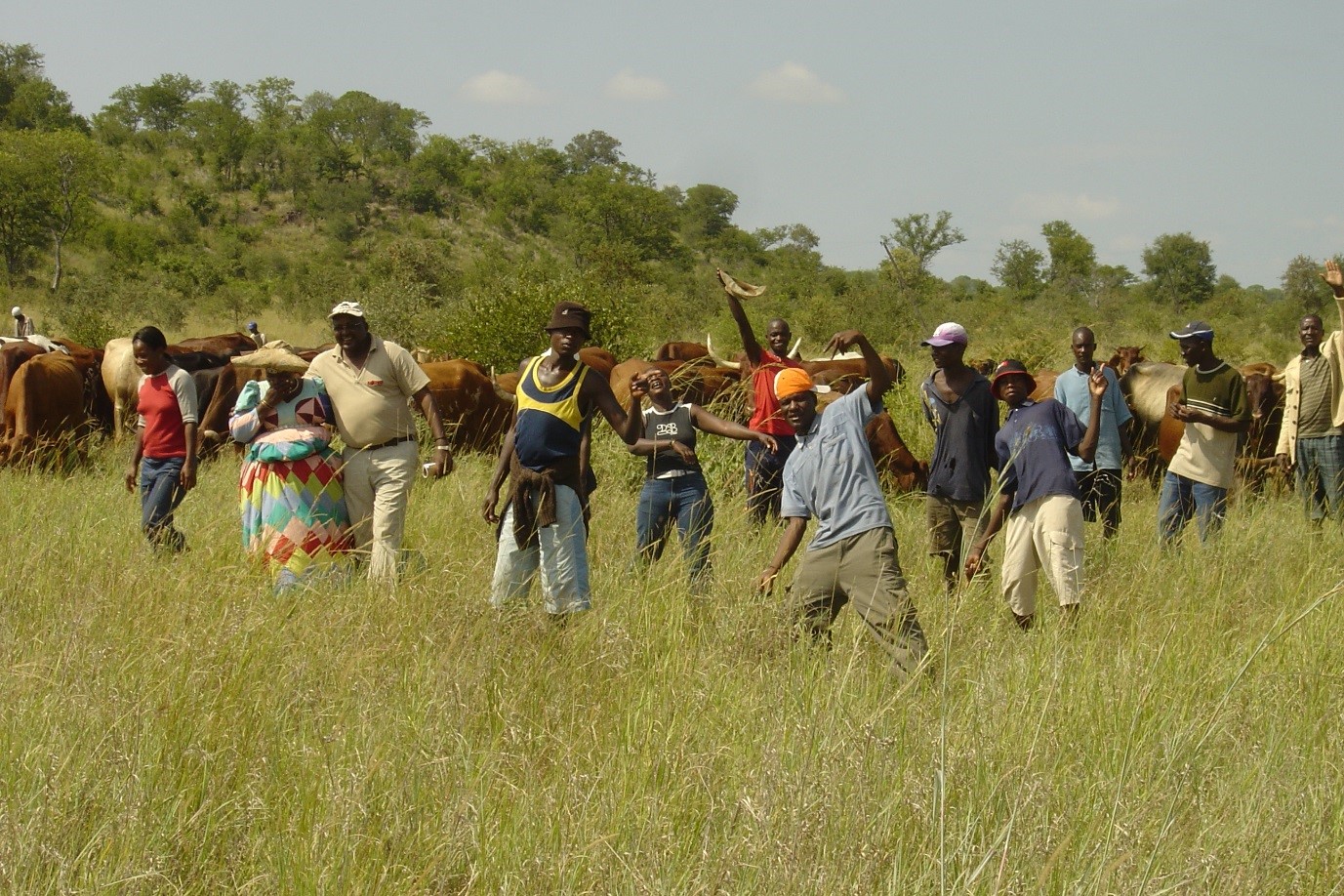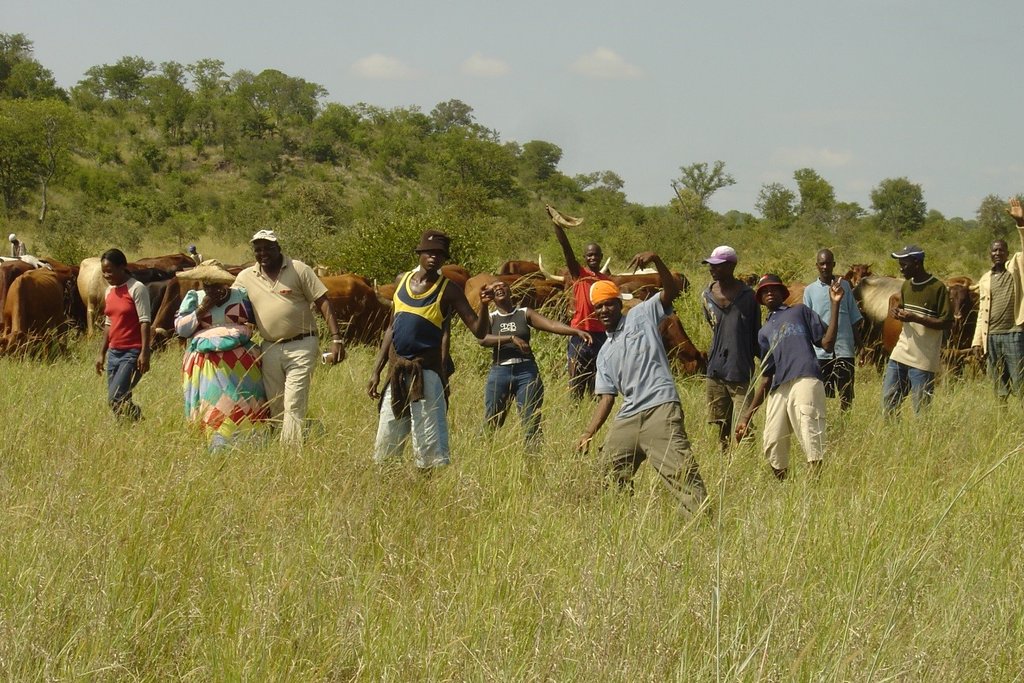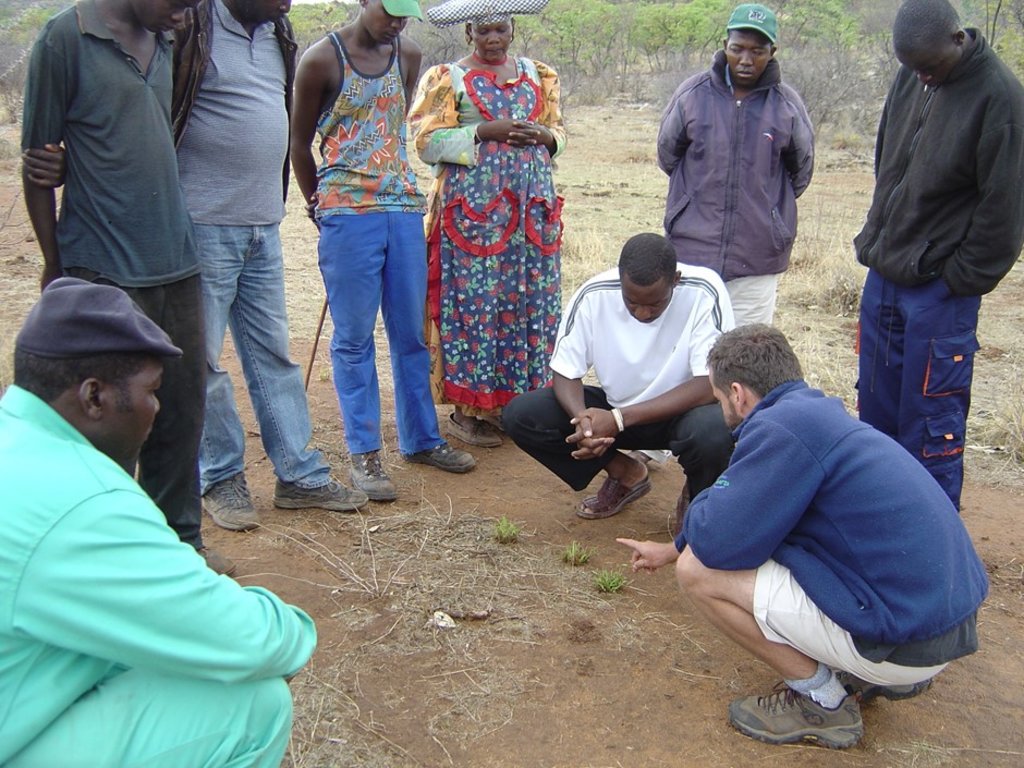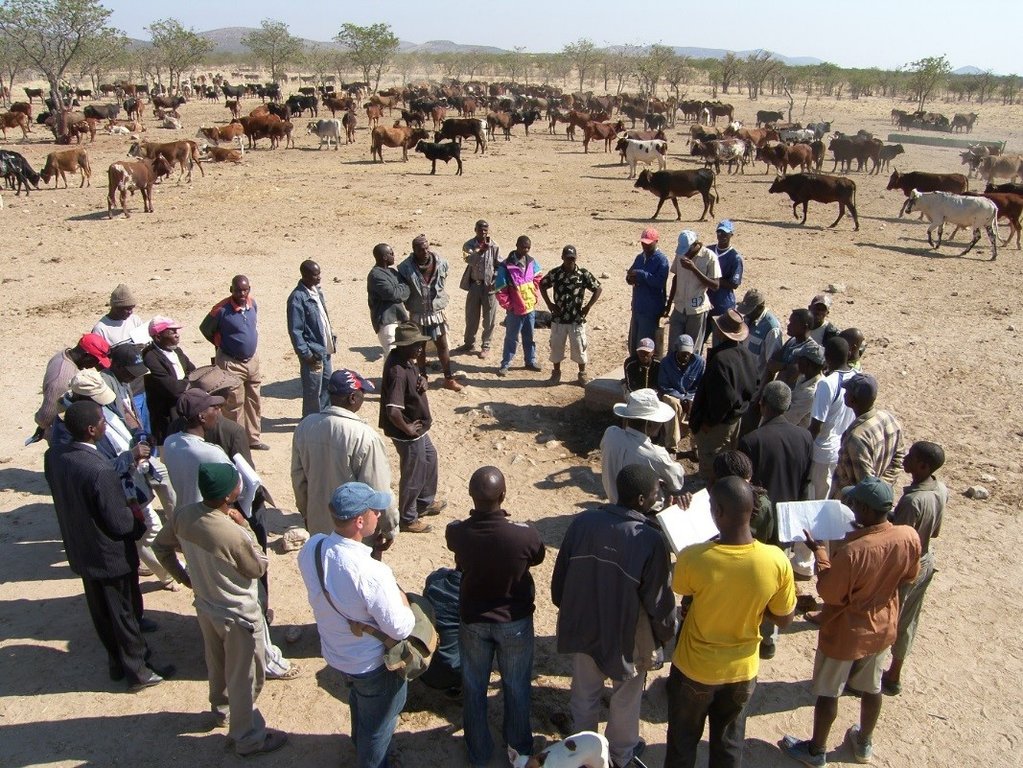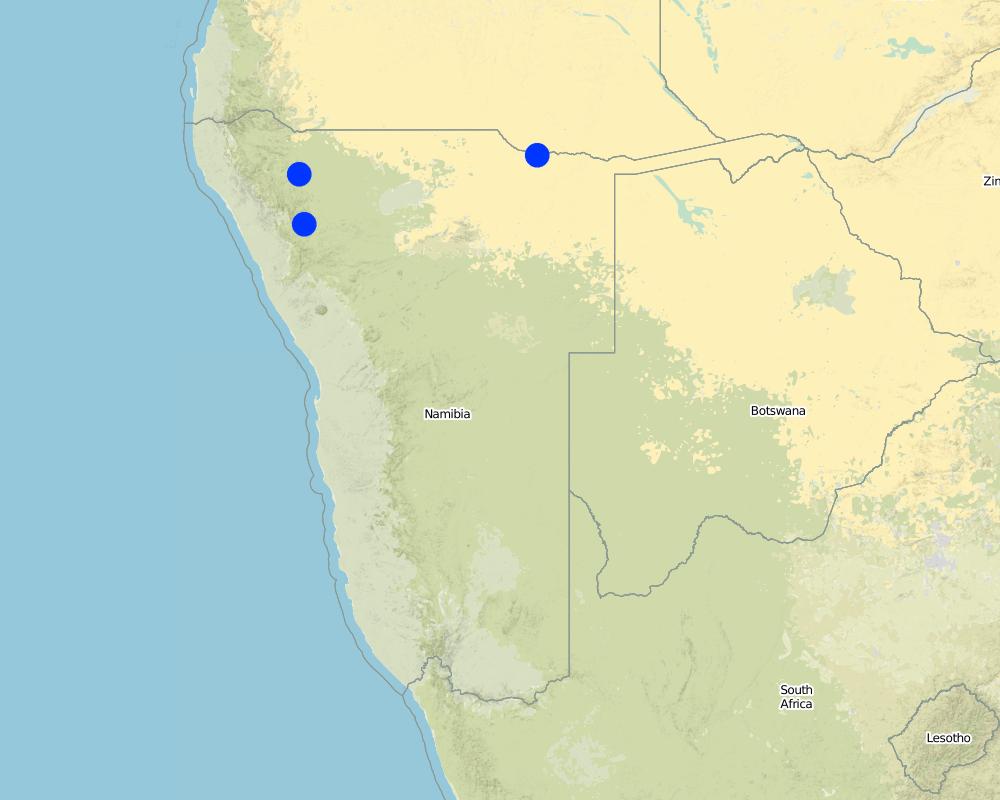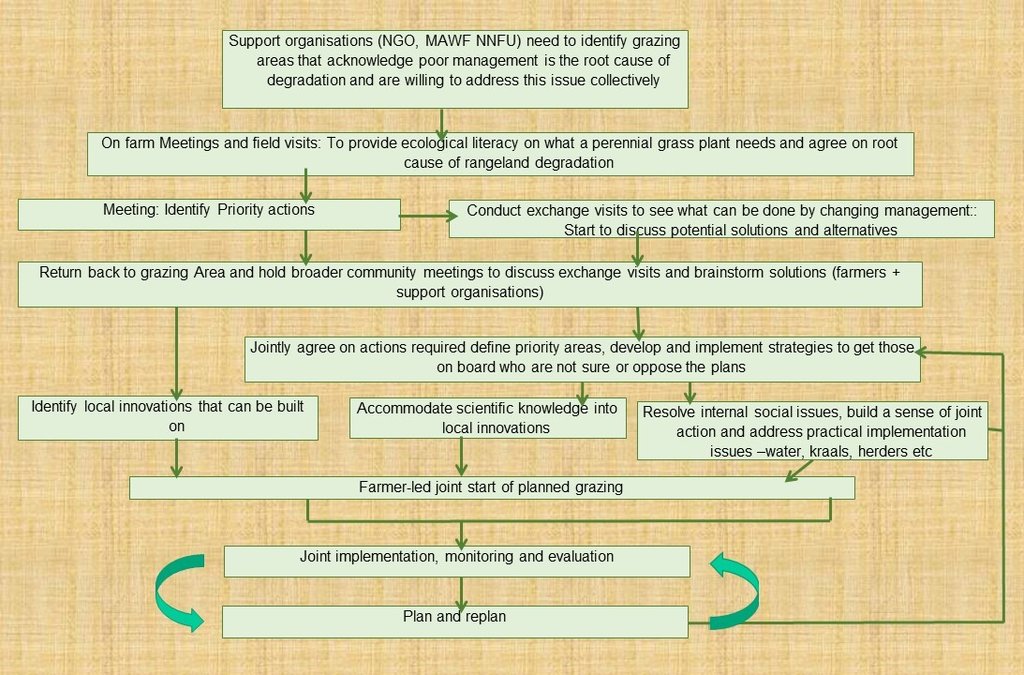Commuity grazing management [Namibia]
- Creación:
- Actualización:
- Compilador: Ibo Zimmermann
- Editor: –
- Revisor: Rima Mekdaschi Studer
Omarisiro wovinamuinjo motjimbumba
approaches_3050 - Namibia
Visualizar secciones
Expandir todo Colapsar todos1. Información general
1.2 Detalles de contacto de las personas de referencia e instituciones involucradas en la evaluación y la documentación del Enfoque
Usuario de la tierra:
Nombre del proyecto que facilitó la documentación/ evaluación del Enfoque (si fuera relevante)
Southern African Science Service Centre for climate change and Adaptive Land management (SASSCAL)Nombre de la(s) institución(es) que facilitaron la documentación/ evaluación del Enfoque si fuera relevante)
Conservation Agriculture Namibia (Conservation Agriculture Namibia) - NamibiaNombre de la(s) institución(es) que facilitaron la documentación/ evaluación del Enfoque si fuera relevante)
Zakumuka Producers Co-operative (Zakumuka Producers Co-operative) - Namibia1.3 Condiciones referidas al uso de datos documentados mediante WOCAT
¿Cuándo se compilaron los datos (en el campo)?
2017
El compilador y la/s persona(s) de referencia claves aceptan las condiciones acerca del uso de los datos documentados mediante WOCAT :
Sí
1.4 Referencia/s al/los Cuestionario(s) de Tecnologías MST
2. Descripción del Enfoque MST
2.1 Breve descripción del Enfoque
Agreement among community members to jointly manage their communal grazing area by combining their livestock into a single herd. The herd is managed and moved according to an agreed growing season plan that provides sufficient recovery for perennial grasses, and a non-growing season plan to graze in a way that prepares soil and plants for the next season. Regenerating rangeland productivity and well-being is the goal.
2.2 Descripción detallada del Enfoque MST
Descripción detallada del Enfoque MST:
The approach is a partnership between an NGO, Ministry of Land Reform (MLR), Ministry of Agriculture , Water and Forestry (MAWF), the National Farmers Union (NNFU), traditional authorities, and regional and local government. The NGO raises awareness among the community about the damage caused to the rangeland by individual herds of livestock grazing continuously – and to appreciate the benefits of planned grazing. Livestock owners invite facilitators to compare the current state of their land with that of the past. The reasons for the decline are investigated. Once livestock owners understand that perennial grasses need recovery, they soon conclude that their management caused the loss of perennial grass and the increase in bare ground. At this point, the aim of the approach can be pursued. This is to regenerate rangeland productivity in the communal grazing area and thereby support higher livestock production. This in turn supports livelihoods.
If motivation to apply planned grazing exists among the community members, then their right to claim common property ownership needs to be established. In pioneering communities this requires at least 10 village level livestock owner meetings to decide on modalities of planned grazing. These meetings continue after planned grazing has started to deal with ongoing planning, animal production and marketing. Exposure visits to areas with successful grazing management help. On return frequent follow-up meetings, facilitated by the NGO and the MAWF, can resolve local issues, including traditional taboos, such as combining animals in one kraal, and whose bulls should be kept and managed.
Boundaries with neighbouring communities need to be mapped, recognised and respected by all. In case of grass poaching, the offenders must to be swiftly dealt with, preferably through customary law. A grazing plan needs to be agreed by all livestock owners, and endorsed by the local Traditional Authority. The grazing area (GA) is then mapped, while six herders, one of whom is their manager, are appointed from among the community though common agreement. Each livestock owner pays a portion of the herding and management cost pro-rata based on the number of his livestock. At night the cattle are separated and kraaled near the homesteads of their owners. In the morning, the herders collect cattle from the kraals. Different portions of the grazing area are grazed daily and only returned to when the grass has replenished its root reserves - some months later.
The process started at Erora in 2004, facilitated by the NGO, Integrated Rural Development and Nature Conservation (IRDNC). Implementation began in 2006, combining approximately 1200 cattle from 12 households. Livestock owners noticed a higher density of annual grasses after the first season; dramatic improvement in soil cover after three years with emergence of grass seedlings where none had grown for decades. Then after another three years, perennial grasses returned with increased biodiversity in many parts. However, when the extended drought started in 2011, planned grazing was interrupted and gullies expanded, down which rainwater flowed, dehydrating the rangelands. The drought lasted for five years, and the planned grazing was temporarily discontinued in 2013. During this period, rehabilitation work included constructing bush filters along key gullies: facilitation was taken over by another NGO, Conservation Agriculture Namibia (CAN). After successive years of severe drought, cattle became too weak to be rounded up, and in 2014 the community members decided to revert to keeping cattle near their homesteads. This was intended to be temporary but cattle only gained sufficient strength in 2017. The communal grazing management approach was extended to other villages in 2012, despite the drought. New boreholes were drilled and installed to facilitate improved planned grazing.
2.3 Fotos del Enfoque
2.4 Videos del Enfoque
Comentarios, descripción breve:
www.youtube.com/watch?v=xNyFkDUH6MQ
This video is from a DVD created by the Integrated Rural Development and Nature Conservation (IRDNC), a Namibian NGO and co-sponsored by the Namibian Ministry of Agriculture and the Namibian National Farmers Union. The video documents the development of a rangeland program focused on Holistic Management, spearheaded by Colin Nott, a Holistic Management educator.
Fecha:
2007
Lugar:
Erora, Namibia
Nombre del videógrafo:
Andrew Botelle
Comentarios, descripción breve:
www.youtube.com/watch?v=3Ey5v40KtkI
Combined herding to manage communal grazing with the use of stress-free handling of cattle,
Fecha:
2007
Lugar:
Erora, Namibia
Nombre del videógrafo:
Andrew Botelle
Comentarios, descripción breve:
www.youtube.com/watch?v=6C4V_Cib8ts
Managing water flow to repair gully erosion
Fecha:
2015
Lugar:
Namibia
Nombre del videógrafo:
Andrew Botelle
2.5 País/ región/ lugares donde el Enfoque fue aplicado
País:
Namibia
Región/ Estado/ Provincia:
Kunene Region
Especifique más el lugar :
Erora village, 18.32637 South, 14.05912 East
Map
×2.6 Fechas de inicio y conclusión del Enfoque
Indique año del inicio:
2004
Comentarios:
Combined herding was discontinued at Erora in 2013 due to extreme drought, which ended in 2016/2017 rainy season, and land users are planning to use reserved grazing, whereby cattle are taken out each day by herders and left there to return on their own to water points. In the meantime, combined herding has already resumed at the Outokotorua grazing area.
2.7 Tipo de Enfoque
- Science informs the traditional practice
2.8 Propósitos/ objetivos principales del Enfoque
To regenerate rangeland productivity for supporting livelihoods and improved quality of life.
2.9 Condiciones que facilitan o impiden la implementación de la/s Tecnología/s aplicadas bajo el Enfoque
normas y valores sociales/ culturales/ religiosos
- facilitan
Herding is customary, and the task is now shared among families
- impiden
Herding no longer carries the high social status that it had previously.
disponibilidad/ acceso a recursos y servicios financieros
- facilitan
No bought inputs are required, and fewer herders needed than with many small herds. Also fewer losses from stock theft and predators
entorno institucional
- facilitan
A grazing area committee was established with support of livestock owners
- impiden
The grazing area committee is not legally recognised
colaboración/ coordinación de actores
- facilitan
Partnership approach with MLR, Ministry of Agriculture, Water and Forestry (MAWF) the NNFU, traditional authorities and regional and local government.
- impiden
Resolution of local issues to apply grazing plans needs to be resolved
marco de trabajo legal (tenencia de tierra, derechos de uso de tierra y agua)
- facilitan
National Policy and strategy is in place which supports sound management principles
- impiden
Grass poaching by neighbouring communities is not adequately dealt with by the law
políticas
- facilitan
The approach is based upon the Namibia National Rangeland Management Policy and Strategy
- impiden
Common property rights are insufficiently promoted
gobernanza de tierras (toma de decisiones, implementación y aplicación)
- impiden
Lack of integration of different scales of management between conservancies at large scales and grazing areas at smaller scale is required
conocimiento de MST, acceso a apoyo técnico
- facilitan
The awareness exists among participating livestock owners and stakeholders
mercados (para comprar insumos, vender productos) y precios
- facilitan
The Namibia National Farmers Union is busy addressing markets north of the veterinary cordon fence, which maintains a zone free of foot-and-mouth disease to the south from where farmers are able to access the lucrative EU market
- impiden
During drought the drop in prices from sudden increase in supply, results in inability of farmers to sell livestock when sudden shortage of forage occurs
carga de trabajo, disponibilidad de mano de obra
- facilitan
Fewer herders are required for one large herd than for many small herds
- impiden
The role of herders as rangeland managers lacks status and is not adequately appreciated, resulting in high turnover of trained herders and their manager.
otros
- impiden
One large livestock owner at a given place can hinder efforts of the majority to improve rangeland management
3. Participación y roles de las partes interesadas involucradas
3.1 Partes interesadas involucradas en el Enfoque y sus roles
- usuarios locales de tierras/ comunidades locales
Communities of Erora, Outokotorua and Nsindi
To organise, plan and implement
- organizaciones comunitarias
Grazing Committee
Oversee day to day implementation
- especialistas MST/consejeros agrícolas
Integrated Rural Development and Nature Conservation (IRDNC), then Conservation Agriculture Namibia (CAN) and Namibia National Farmers Union (NNFU)
To facilitate adoption and upscaling of the approach
- investigadores
United States Department of Agriculture (USDA)
To assess rangeland condition changes
- ONG
First IRDNC, then CAN
To facilitate the approach
- sector privado
Zakumuka Producers Cooperative
To organise auctions for sale of livestock
- gobierno local
Traditional authorities
To support and enable agreed rules
- gobierno nacional (planificadores, autoridades)
Namibian Ministries of Lands & Agriculture
Assist with facilitation and support
- Farmers union
Namibia National Farmers Union
Enabling policy and legislation
Si varias partes interesadas estuvieron involucradas, indique la agencia principal:
Integrated Rural Development and Nature Conservation (IRDNC), taken over in 2014 by Conservation Agriculture Namibia (CAN)
3.2 Involucramiento de los usuarios locales de tierras/ comunidades locales en las distintas fases del Enfoque
| Involucramiento de los usuarios locales de tierras/ comunidades locales | Especifique quién se involucró y describa las actividades | |
|---|---|---|
| iniciación/ motivación | interactivo | The community, with focus on livestock owners, youth, women and herders, under facilitation by NGO by conducting exchange visits to neighbouring countries |
| planificación | interactivo | Feedback was given to communities by participants of exchange visits, grazing committees appointed to contextualise and re-plan for the way forward under guidance of NGO, Ministry of Agriculture, Water and Forestry (MAWF) and Namibia National Farmers Union (NNFU) |
| implementación | interactivo | The grazing committee, livestock owners and herders carry out the grazing plan with support of NGO, MAWF and NNFU |
| monitoreo y evaluación | interactivo | The grazing committee and livestock owners constantly plan and replan and evaluate results on livestock performance and rangeland and daily check where livestock have grazed and where they will graze next and feed results into re-planning. Annual assessments of forage in May, to determine stocking rate. |
| external assessment of data | apoyo externo | External assessment by researchers of data gathered by USDA through Innovations for Poverty Action (IPA) |
3.3 Flujograma (si estuviera disponible)
Descripción:
Flow chart of the process to facilitate community grazing management.
Autor:
Colin Nott
3.4 La toma de decisiones en la selección de Tecnología(s) MST
Especifique quién decidió la selección de las Tecnología/ Tecnologías a implementarse:
- principalmente usuarios de tierras con el apoyo de especialistas MST
Explique:
After exposure to sound management techniques and on farm identification and agreement on the root cause of the degradation – the farmers themselves decide if they will continue or not.
Especifique las bases que sustentaron la toma de decisiones:
- la evaluación de conocimiento MST bien documentado (la toma de decisiones se basa en evidencia)
- la experiencia personal y opiniones (no documentadas)
4. Apoyo técnico, fortalecimiento institucional y gestión del conocimiento
4.1 Construcción de capacidades / capacitación
¿Se proporcionó la capacitación a usuarios de tierras/ otras partes interesadas?
Sí
Especifique quién fue capacitado:
- usuarios de tierras
- personal de campo/ consejeros
- Ministry of Agriculture, Namibia National Farmers Union.
Si fuese relevante, también especifique género, edad, estatus, etnicidad, etc.
Inclusion of youth, women and herders.
Forma de capacitación:
- en el contexto de trabajo
- de agricultor a agricultor
- reuniones públicas
Temas avanzados:
On farm(s) exploration of root cause of degradation based on how it was in the past and how it looks now and why this change has happened.
Comentarios:
A number of issues including: Rangeland management, focussing on the needs of grass plants and soil. Needs of herders, people and stakeholders and how these various needs can be met. Institutional support for grazing committee, focussing on budgeting and financial management.
4.2 Servicio de asesoría
¿Los usuarios de tierras tienen acceso a un servicio de asesoría?
Sí
Especifique si servicio proporcionado se realizó:
- en los campos de los usuarios de tierras
- Visits to successful farmers
Describa/ comentarios:
Mostly through exchange visits, community meetings, on farm excursions and on-the-job training.
4.3 Fortalecimiento institucional (desarrollo institucional)
¿Se establecieron o fortalecieron instituciones mediante el Enfoque?
- sí, mucho
Especifique el nivel o los niveles en los que se fortalecieron o establecieron las instituciones:
- local
- regional
Describa la institución, roles y responsabilidades, miembros, etc.
Grazing Committee guides and implements the grazing plans and support organisations including Ministry of Agriculture, Namibia National Farmers Union and NGOs provide support and advice.
Especifique el tipo de apoyo:
- construcción de capacidades/ entrenamiento
- equipo
Proporcione detalles adicionales:
Exchange visits, facilitation of meetings and on-the-job training. Drilling and equipping of boreholes. Redesign of water supply for livestock and combined kraaling system.
4.4 Monitoreo y evaluación
¿El monitoreo y la evaluación forman parte del Enfoque?
Sí
Comentarios:
To support decision making
Si respondió que sí, ¿la documentación se utilizará para monitoreo y evaluación?
No
4.5 Investigación
¿La investigación formó parte del Enfoque?
Sí
Especifique los temas:
- sociología
- economía/ marketing
- ecología
Proporcione detalles adicionales e indique quién hizo la investigación:
USDA/IPA came to evaluate rangelands and consult key stakeholders
5. Financiamiento y apoyo material externo
5.1 Presupuesto anual para el componente MST del Enfoque
Indique el presupuesto anual para el componente del MST del Enfoque (en US$):
10000,00
Si no se conoce el presupuesto anual preciso, indique el rango:
- 10,000-100,000
Comentarios (ej. fuentes principales de financiamiento/ donantes principales):
Major donor to initiate the project was Enagelica Entwikelins Diens (EED), through IRDNC and later funding came from the Millenium Challenge Account (MCA), the EU and now the Finnish Embassy through CAN. Cost is per grazing area for local level field facilitation.
5.2 Apoyo financiero/material proporcionado a los usuarios de tierras
¿Los usuarios de tierras recibieron financiamiento/ apoyo material para implementar la Tecnología/ Tecnologías? :
Sí
Si respondió sí, especifique el tipo o los tipos de apoyo, condiciones y proveedor(es) :
Upgrades of boreholes, drilling and equipping of new boreholes that are elephant-proof and construction of lion-proof kraaling was funded through the NGO.
5.3 Subsidios para insumos específicos (incluyendo mano de obra)
- mano de obra
| En qué grado | Especifique los subsidios |
|---|---|
| parcialmente financiado | Part payment to herders 2004-2007 in Erora only |
- otro
| Otro (especifique) | En qué grado | Especifique los subsidios |
|---|---|---|
| Boreholes and kraals | parcialmente financiado | Erora upgrade USD 10 000, second solar borehole half funded by community USD 10 000. Lion proof kraal funded by Africat – USD 2 000 |
Si la mano de obra de usuarios de tierras fue un insumo sustancial, ¿fue:
- pagado en efectivo?
Comentarios:
Only for first four years at one of the villages to enable proof of concept to be established.
5.4 Crédito
¿Se proporcionó crédito bajo el Enfoque para actividades MST?
No
5.5 Otros incentivos o instrumentos
¿Se usaron otros incentivos o instrumentos para promover la implementación de Tecnologías MST?
No
6. Análisis de impacto y comentarios de conclusión
6.1 Impactos del Enfoque
¿El Enfoque empoderó a los usuarios locales de tierras, mejoró el involucramiento de las partes interesadas?
- No
- Sí, un poco
- Sí, moderadamente
- Sí, mucho
Through the whole approach.
¿El Enfoque facilitó la toma de decisiones basada en evidencia?
- No
- Sí, un poco
- Sí, moderadamente
- Sí, mucho
Through observations by herders and livestock owners.
¿El Enfoque ayudó a los usuarios de tierras a implementar y mantener Tecnologías MST?
- No
- Sí, un poco
- Sí, moderadamente
- Sí, mucho
Combined herding through planned grazing.
¿El Enfoque mejoró la coordinación e implementación efectiva en costos de MST?
- No
- Sí, un poco
- Sí, moderadamente
- Sí, mucho
Key stakeholders are all involved.
¿El Enfoque movilizó/mejoró el acceso a recursos financieros para implementar MST?
- No
- Sí, un poco
- Sí, moderadamente
- Sí, mucho
¿El Enfoque mejoró el conocimiento y capacidades de los usuarios para implementar MST?
- No
- Sí, un poco
- Sí, moderadamente
- Sí, mucho
Training provided the skills to self organise and implement activities based upon identification of root cause of land degradation.
¿El Enfoque mejoró el conocimiento y capacidades de otras partes interesadas?
- No
- Sí, un poco
- Sí, moderadamente
- Sí, mucho
Ministries of Agriculture and Lands.
¿El Enfoque construyó/ fortaleció instituciones, colaboración entre partes interesadas?
- No
- Sí, un poco
- Sí, moderadamente
- Sí, mucho
Key stakeholders are all collaborating, since the solution to rangelands cuts across various sectors.
¿El Enfoque mitigó conflictos?
- No
- Sí, un poco
- Sí, moderadamente
- Sí, mucho
Reinstated sense of community
¿El Enfoque empoderó a grupos en desventaja social y económica?
- No
- Sí, un poco
- Sí, moderadamente
- Sí, mucho
Women-headed households now have their livestock herded communally.
¿El Enfoque mejoró la equidad de género y empoderó a las mujeres y niñas?
- No
- Sí, un poco
- Sí, moderadamente
- Sí, mucho
Women-headed households now have their livestock herded communally.
¿El Enfoque alentó a jóvenes/ la siguiente generación de usuarios de tierras a involucrarse con MST?
- No
- Sí, un poco
- Sí, moderadamente
- Sí, mucho
Herders are mainly youth and young livestock owners, who appreciate improved rangeland and are now willing to remain.
¿El Enfoque mejoró cuestiones de tenencia de tierra/ derechos de usuarios que obstaculizaron la implementación de la Tecnologías MST?
- No
- Sí, un poco
- Sí, moderadamente
- Sí, mucho
The willingness to address appropriate land rights may initiate resolution of land issues.
¿El Enfoque resultó en mejor seguridad alimentaria/ mejoró la nutrición?
- No
- Sí, un poco
- Sí, moderadamente
- Sí, mucho
Much during good rains and little during drought.
¿El Enfoque mejoró el acceso a los mercados?
- No
- Sí, un poco
- Sí, moderadamente
- Sí, mucho
¿El Enfoque llevó a un acceso mejorado a tierra y saneamiento?
- No
- Sí, un poco
- Sí, moderadamente
- Sí, mucho
Access to borehole water was provided.
¿El Enfoque llevó a un uso más sostenible/ fuentes de energía?
- No
- Sí, un poco
- Sí, moderadamente
- Sí, mucho
Solar installations were installed or replaced diesel where possible for pumping of water.
¿El Enfoque mejoró la capacidad de los usuarios de tierras a adaptarse a los cambios climáticos/ extemos y mitigar desastres relacionados al clima?
- No
- Sí, un poco
- Sí, moderadamente
- Sí, mucho
Improved grass growth in good rain years and improved survival in drought.
¿El Enfoque llevó a oportunidades de empleo, ingresos?
- No
- Sí, un poco
- Sí, moderadamente
- Sí, mucho
Herders and managers were appointed.
6.2 Motivación principal del usuario de la tierra para implementar MST
- producción incrementada
Increased grass, higher calving and reduced mortalities.
- incremento de la renta(bilidad), proporción mejorada de costo-beneficio
Increased grass, higher calving and reduced mortalities.
- reducción de la degradación de la tierra
Changing unsustainable practices for improved resource base.
- carga de trabajo reducida
Fewer herders needed.
- prestigio, presión social/ cohesión social
Social cohesion to implement joint management.
- conciencia medioambiental
To support the future of livestock in their area.
6.3 Sostenibilidad de las actividades del Enfoque
¿Pueden los usuarios de tierras sostener lo que se implementó mediante el Enfoque (sin apoyo externo)?
- sí
Si respondió que sí, describa cómo:
They mobilise themselves, appoint herders, do the implementation, do the planning jointly and, and only asking for some technical support.
6.4 Fortalezas/ ventajas del Enfoque
| Fuerzas/ ventajas/ oportunidades desde la perspectiva del usuario de la tierra |
|---|
| By caring for the rangeland, farmers will have grass all year round and minimise effects of drought. |
| Fuerzas/ ventajas/ oportunidades desde la perspectiva del compilador o de otra persona de referencia clave |
|---|
| It has proven to improve the resource base if applied properly. |
| It is viable and upscalable. |
| It has diverse benefits for the land user, including economic, social and environmental. |
6.5 Debilidades/ desventajas del Enfoque y formas de sobreponerse a ellos
| Debilidades/ desventajas/ riesgos desde la perspectiva del usuario de la tierra | ¿Cómo sobreponerse a ellas? |
|---|---|
| If a new water point needs to be developed, then funds will be required | Convince land users that by selling one or a few cattle to invest in a new water point, they will realise the returns from increased productivity within a few years. |
| Debilidades/ desventajas/ riesgos desde la perspectiva del compilador o de otra persona de referencia clave | ¿Cómo sobreponerse a ellas? |
|---|---|
| The herding is hard work, the status of herders is perceived to be low and they are poorly compensated. |
Convince livestock owners that they can adequately afford to compensate the herders. Start national and regional vocational training in herding, grazing management, low-stress handling, animal health, rangeland management, water management and financial and farm management. |
7. Referencias y vínculos
7.1 Métodos/ fuentes de información
- visitas de campo, encuestas de campo
- entrevistas con usuarios de tierras
- entrevistas con especialistas/ expertos en MST
7.2 Referencias a publicaciones disponibles
Título, autor, año, ISBN:
Global case studies of grazing in nature’s image, Jim Howell, 2008, 1-4392-1610-X
¿Dónde se halla disponible? ¿Costo?
www.booksuge.com
7.3 Vínculos a la información relevante disponible en línea
Título/ descripción:
Community based rangeland and livestock management
URL:
https://rmportal.net/groups/cbrlm/cbrlm-for-review/namibia-community-based-rangeland-livestock-management-cbrlm-2nd-edition/view
Vínculos y módulos
Expandir todo Colapsar todosVínculos
No hay vínculos
Módulos
No se hallaron módulos


